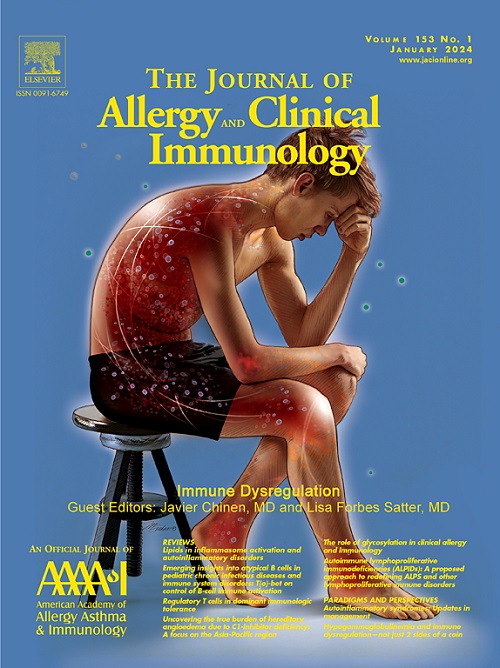抗原特异性免疫反应和微生物群在皮肤中的相互作用:对自身免疫性皮肤病和。
IF 11.2
1区 医学
Q1 ALLERGY
引用次数: 0
摘要
皮肤起着至关重要的作用,作为一个物理和免疫屏障,抵御外部的侮辱,同时协调复杂的免疫反应。自身免疫性皮肤病,包括天疱疮、白癜风和斑秃,说明了抗原特异性免疫和组织特异性病理之间复杂的相互作用。天疱疮可以作为一个模型来理解外周免疫耐受的动力学以及体液和细胞自身免疫之间的相互作用,强调调节性T细胞在控制自身反应反应中的作用。同样,白癜风和斑秃强调了常驻记忆CD8+ T细胞和IFN-γ信号的病理贡献,确定了潜在的治疗靶点,如IL-15信号通路,以解决疾病的难治性。除了自身免疫机制,皮肤微生物群深刻影响局部和全身免疫反应。共生菌如表皮葡萄球菌通过调节屏障完整性、T细胞活化和伤口修复来促进体内平衡,而生态失调加剧了免疫失调。创新的策略,包括使用转基因微生物来刺激抗原特异性免疫,为下一代疗法带来了希望。这篇综述强调了抗原特异性免疫在皮肤疾病中的重要性以及微生物群在调节免疫反应中的新作用。未来对这些领域的研究对于推进靶向治疗和理解皮肤健康和全身免疫的相互联系至关重要。本文章由计算机程序翻译,如有差异,请以英文原文为准。
Antigen-specific immune responses and microbiota interactions in skin: Insights into autoimmune skin diseases and emerging therapeutic strategies
The skin plays a vital role in serving as a physical and immunologic barrier against external insults while orchestrating complex immune responses. Autoimmune skin diseases including pemphigus, vitiligo, and alopecia areata illustrate the intricate interplay between antigen-specific immunity and tissue-specific pathologies. Pemphigus serves as a model to understand the dynamics of peripheral immune tolerance and the interplay between humoral and cellular autoimmunity, emphasizing the role of regulatory T cells in controlling autoreactive responses. Similarly, vitiligo and alopecia areata highlight the pathological contribution of resident memory CD8+ T cells and IFN-γ signaling, identifying potential therapeutic targets such as the IL-15 signaling pathway to address disease intractability. In addition to autoimmune mechanisms, the skin microbiota profoundly influences local and systemic immune responses. Commensals such as Staphylococcus epidermidis promote homeostasis by regulating barrier integrity, T-cell activation, and wound repair, while dysbiosis exacerbates immune dysregulation. Innovative strategies, including the use of genetically modified microorganisms to stimulate antigen-specific immunity, hold promise for next-generation therapies. This review underscores the significance of antigen-specific immunity in skin diseases and the emerging role of microbiota in modulating immune responses. Future research into these areas is pivotal for advancing targeted therapies and understanding the interconnectedness of skin health and systemic immunity.
求助全文
通过发布文献求助,成功后即可免费获取论文全文。
去求助
来源期刊
CiteScore
25.90
自引率
7.70%
发文量
1302
审稿时长
38 days
期刊介绍:
The Journal of Allergy and Clinical Immunology is a prestigious publication that features groundbreaking research in the fields of Allergy, Asthma, and Immunology. This influential journal publishes high-impact research papers that explore various topics, including asthma, food allergy, allergic rhinitis, atopic dermatitis, primary immune deficiencies, occupational and environmental allergy, and other allergic and immunologic diseases. The articles not only report on clinical trials and mechanistic studies but also provide insights into novel therapies, underlying mechanisms, and important discoveries that contribute to our understanding of these diseases. By sharing this valuable information, the journal aims to enhance the diagnosis and management of patients in the future.

 求助内容:
求助内容: 应助结果提醒方式:
应助结果提醒方式:


